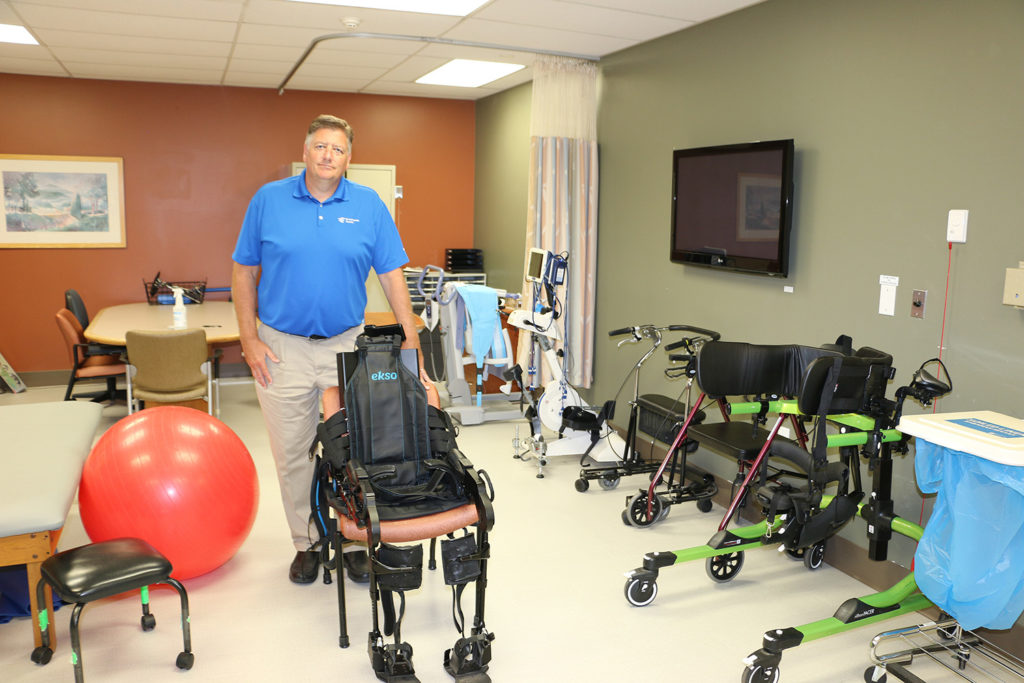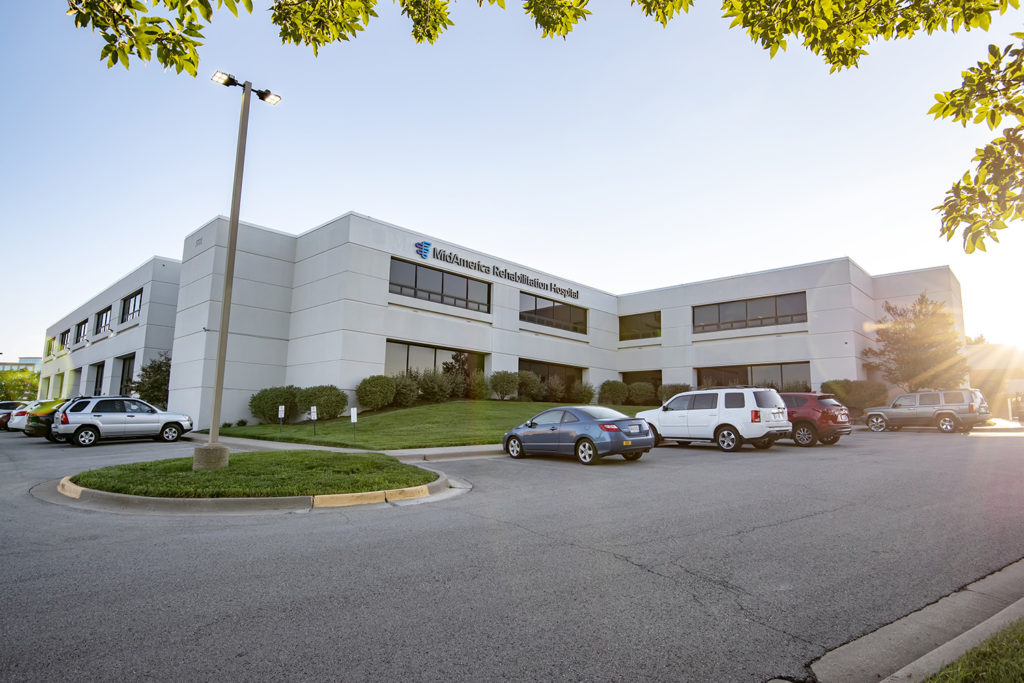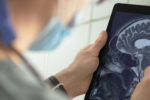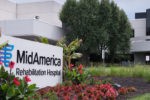Innovative Rehabilitation Technologies

By integrating technology into treatment protocols, MidAmerica Rehabilitation Hospital helps patients get better faster, working towards the best possible outcomes.
Story by Ann Butenas
A lot has changed in the 21+ years Paul Matlack has been with MidAmerica Rehabilitation Hospital (MARH). As Directory of Therapy Operations, Matlack, an occupational therapist, feels a great sense of pride when it comes to being a part of the MARH family.
“We pride ourselves on longevity with the company, and we also value new ideas and evidenced-based practices,” he reflected. “Encompass Health, our parent company, invests in us so we can do the work we love. This includes supporting us at all levels of providing care, whether its hands-on, through various tools, and/or with technology to allow us to further advance our own skills. You don’t get that in every rehabilitation hospital.”
As a 98-bed facility, MARH is the largest rehabilitation hospital in the metro area. With such strong roots, as well, the company realized a strong need for technology within a rehabilitative setting to further enhance the patients’ experience and recovery.
“We are blessed to have access to high-tech robotics and computerized electrical equipment to use with our patients,” emphasized Matlack.
However, this team of clinicians doesn’t just enthusiastically jump at every new product that comes along. A great deal of thought, study, evaluation, and consideration goes into acquiring each piece. While many pieces of technology make the cut, others do not. The focus is on what will best serve the patients to achieve the best overall outcome.

Paul Matlack, Directory of Therapy Operations
Is it Good for Our Company and for Our Patients?
“When we are considering adding a new piece of technology, we initially evaluate it,” noted Matlack. “We have committees to evaluate it, looking for evidence that suggests it works. We run the products through a trial and look at the return on investment to determine its value to us and to our patients.”
For example, in 2015, MARH trialed the EKSO, which is a robotic exoskeletal system.
“This was put through a trial for a national company in 2015,” said Matlack. “Feedback was given, it was revised, and we incorporated it into our tool kit two years later and have used it ever since. It is exciting for us to be a part of such trials.”
Patients also enjoy being a part of a trial for a new piece of technology. They understand the piece is new and that it is being used to determine its efficacy.
“The patients’ feedback is equally important for us, so we want to know if they find it easy to use, if it is comfortable, helpful, and easy to wear,” said Matlack.
Matlack further emphasized how much patients enjoy the robotic exoskeletal system but also emphasized that technology is only part of the equation in therapy.
“We sometimes have to remember that some things can become too high-tech and not user-friendly for us or for our patients,” explained Matlack. “Sometimes, it can be a risk. Will it serve us for years or will it be outdated in a year? Will it require mandatory upgrades that can lead to additional expenses? Those are the issues we must evaluate.”
Virtual Reality (VR) in a Rehabilitation Hospital
While virtual reality products have gained considerable momentum in recent years, most notably among gamers, it does have a place within a clinical setting. This technology can actually be hooked up to an actual gaming system and is a great tool for focusing on balance and visual activities when used appropriately.
“Some of the VR technology available is usable, but some of it can be too complicated and not user-friendly,” said Matlack. “Some VR can be too far advanced and even over-stimulating for some patients.”
Again, when applied in the right setting, VR is a great tool in rehabilitative treatment protocols.
Bioness
MARH has been in partnership with Bioness, a leading provider of innovative technologies that aid in mobility, for many years, beginning with the H200 Hand Rehabilitation System.
“This is a functional electrical stimulation device that is worn on the hand,” said Matlack. “For example, a stroke patient can use it to stimulate the nerves to work in a more functional way as it provides finger and wrist motion. It is used repetitively and then when taken off, we see if the movement continues in the hand. It is based on the theory of neuroplasticity, which basically means the brain will find new pathways to make things work through constant, repetitive motion.”
The L300 Go System is another Bioness device used for lower extremities, such as on the ankle or the thigh, operating on the same theory as the H200.
“If a patient has paralysis in one leg, for example, the device will repetitively go through movement, and when the device is removed, the hope is that the body has found its own path to continue those movements,” said Matlack.
Body Weight Supported Ambulation Systems
These devices allow the patient to walk by supporting them with a harness or hoist. Encompass Health uses one from Bioness with ropes that hang from the ceiling and recognize when the patient is falling or tripping and then provides the necessary support.
“This is great for orthopedic conditions as well as for neurological ones,” noted Matlack. “It makes it safer for patients while they are ambulating.”
Technology for Diagnostics
Matlack emphasized how fortunate the speech therapists at MARH are, as they have access to FEES, which stands for Fiberoptic Endoscopic Evaluation of Swallowing.
“We use this to evaluate swallow more closely after a stroke, for example, to pinpoint what’s happened and to tailor treatment so the patient can recover that function quicker, getting their swallow back faster to ease the burden of care of the patient, who can then resume a normal diet and embrace a quality standard of living,” expressed Matlack.

Low Tech or No Tech – Still a Viable Approach
Just because it doesn’t function like something out of a sci-fi movie set in the year 2075 doesn’t mean it has no place within a rehabilitation hospital. Matlack emphasized that tools used decades ago still have purpose and merit for patients.
“There is still value in those low-tech tools that were used 50-60 years ago, such as blocks, boxes, and cans,” he indicated. “We just have more options now by which to grade activities in a different way.”
MARH also uses a therapeutic swimming pool with one continuous depth (no deep end) for aquatic therapy, which has been around for years. It offers a comfortable and safe environment for patients to relearn certain physical movements.
“The buoyancy of the water helps patients move better and gives them better quality of movement,” noted Matlack. “Patients of all types use it, especially stroke and traumatic brain injury patients.”
Matlack further emphasized technology cannot and should not replace the work of the clinician and the patient, as almost every type of technological equipment used needs to be followed-up with more real-life movements.
“The idea is to use the piece of technology, such as the EKSO, and then move to a walker and then to a cane,” explained Matlack. “The goal is to see improvement outside of the device. We need that outside movement to make it stick and last.”
While technology does advance rapidly and can prove to be somewhat intimidating to certain people, Matlack suggested that, as time goes on, the intimidation factor seems to wane.
“Even older patients are interested and very receptive to what this technology can do,” he explained.
While Matlack may have busy days, he enjoys every minute of it.
“I work with fantastic people who embrace what we do,” he smiled. “Our physicians love it, too, and are quite interested in the new technology available.”
Matlack remains enthusiastic for what types of technology will become available down the road, as well.
“Artificial intelligence is on the horizon, and it does promise to hold positive applications within the medical field,” he reflected.
While technology makes the world of rehabilitative medicine easier for the clinicians, it can also make things more possible for patients, helping them to overcome challenges and work towards the best possible outcomes.






